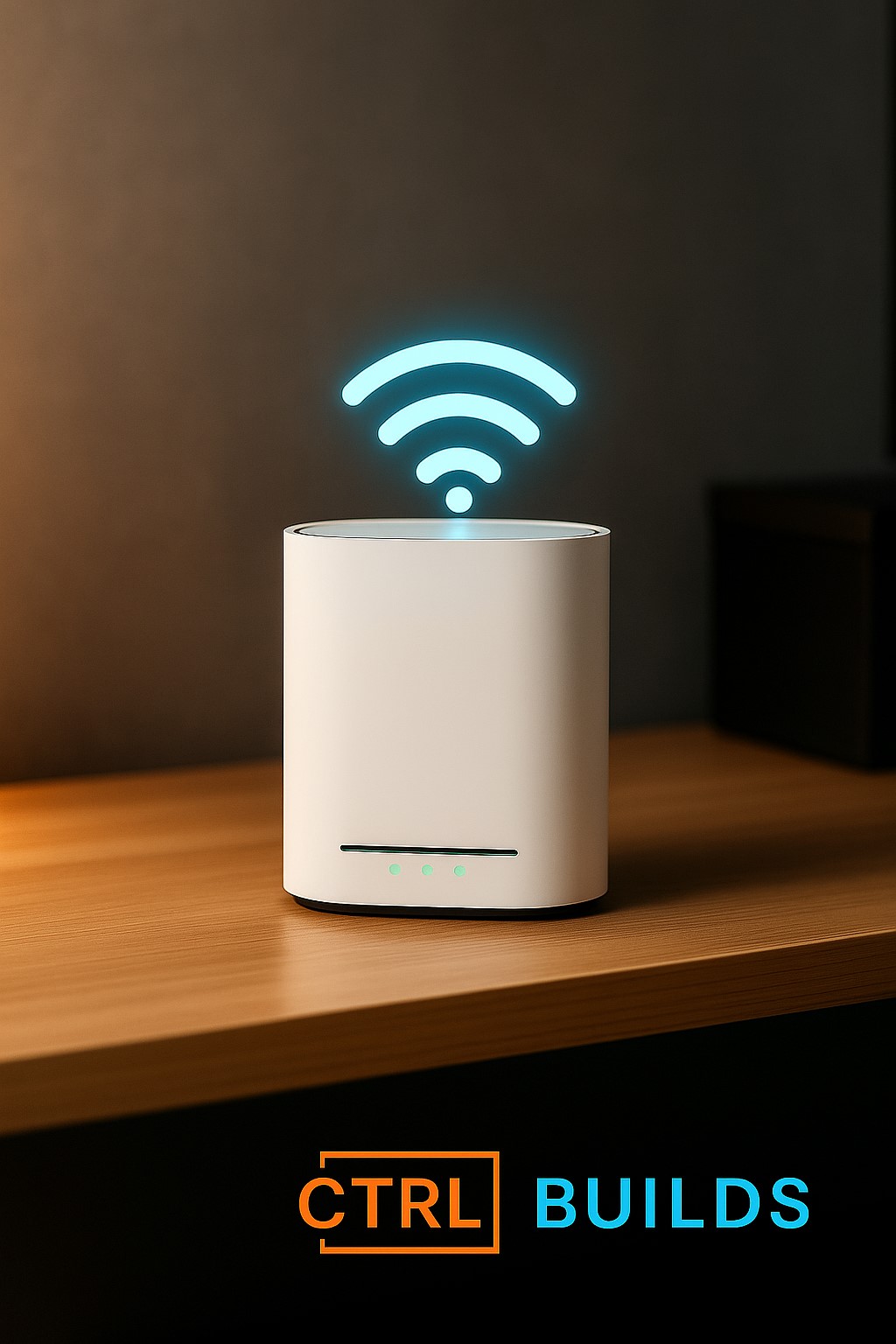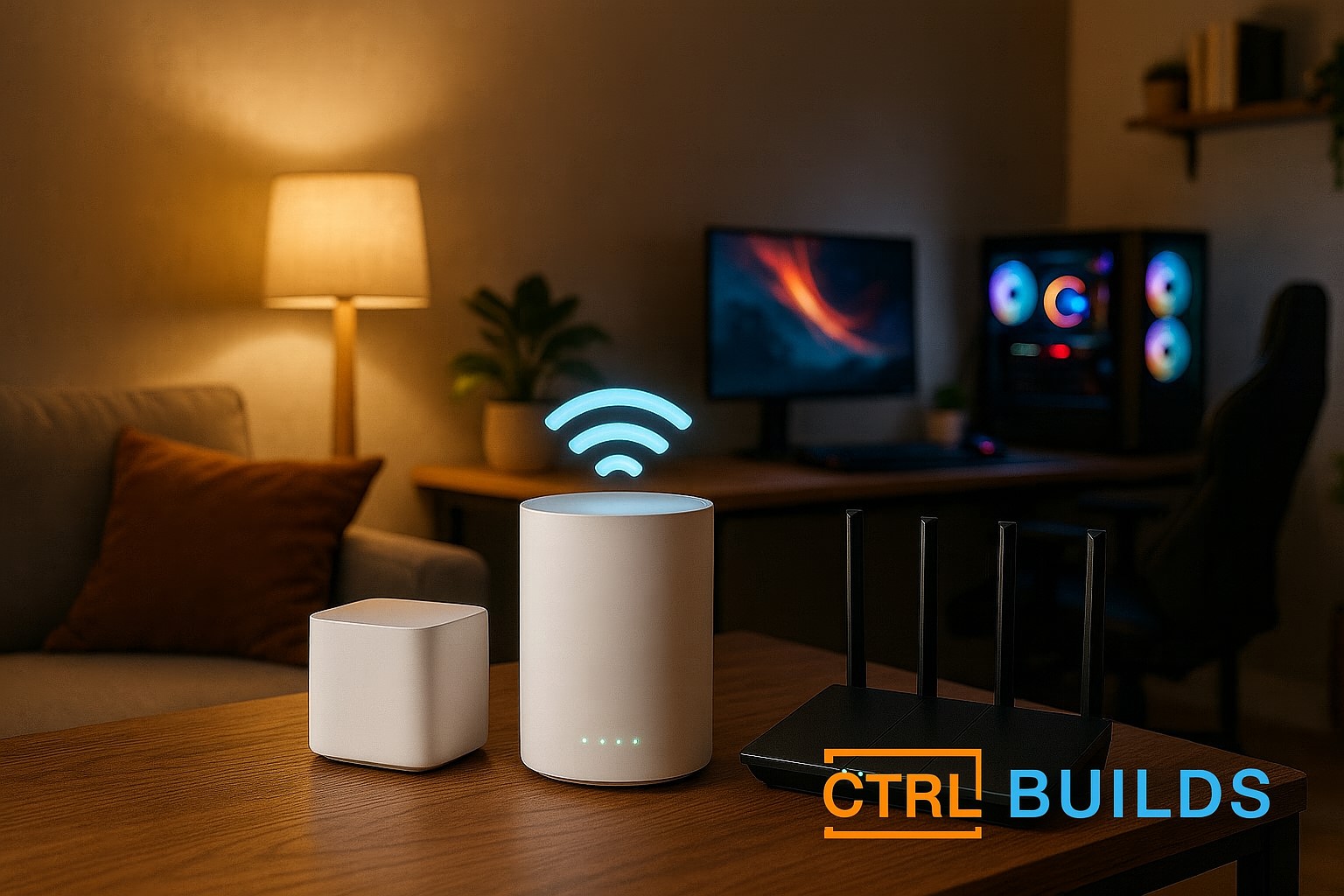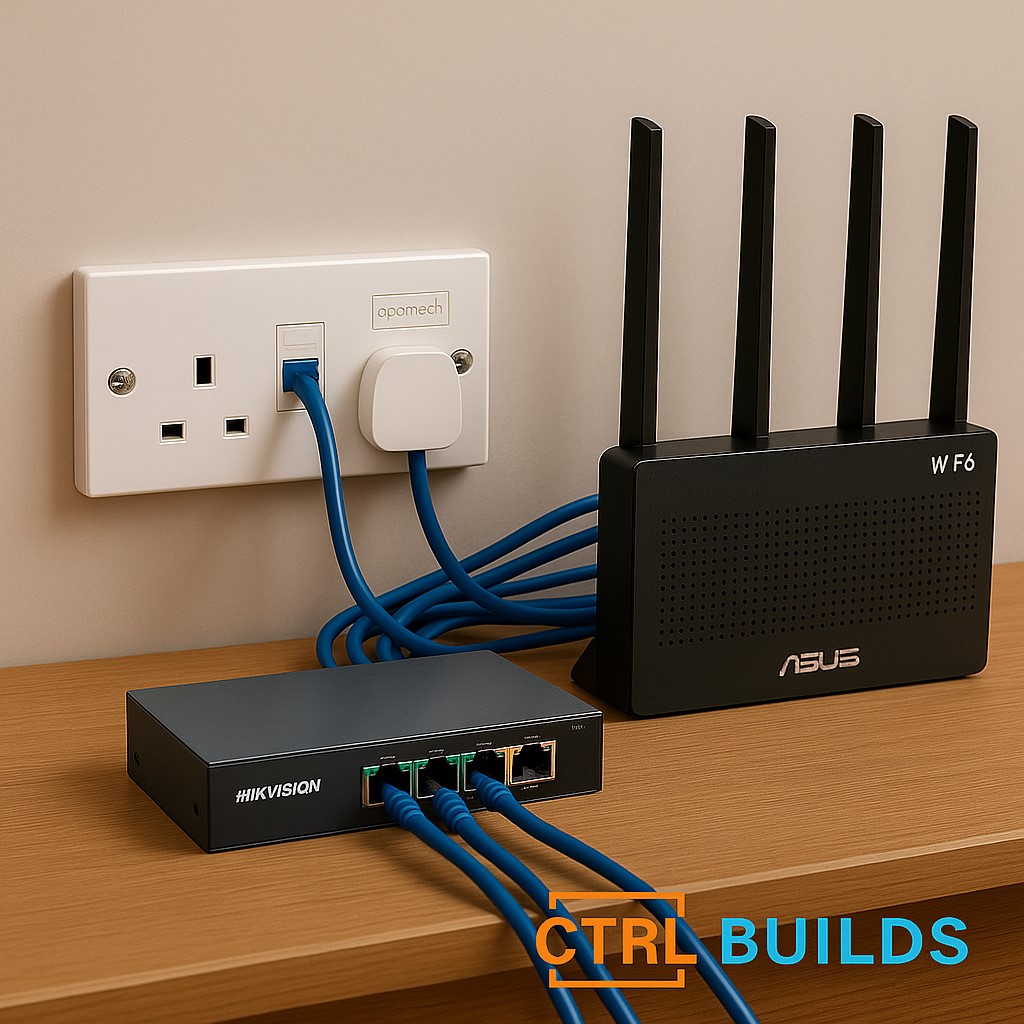Welcome to CTRL Builds — the sharp end of smarter tech.
If your home network still runs on an ageing router and bargain-bin ISP box, 2025 might be the year to rethink your setup. With more UK homes adding smart devices, streaming in 4K, gaming online, and working remotely — often all at once — your connection needs to be fast, stable, and secure.
This guide breaks down everything you need to know to upgrade your home network the right way. Just clean advice based on real-world UK setups, including Wi-Fi 7, mesh systems, Ethernet, and how to avoid common ISP bottlenecks.
Whether you're rewiring your flat or boosting your bungalow’s signal strength, here’s how to take control of your home network.
Modem vs Router in the UK — What You Actually Need
In the UK, most homes are provided a combined modem-router unit from their ISP — often called a “hub.” Examples include the BT Smart Hub, Virgin Hub, or Sky Broadband Hub. These hybrid units simplify setup, but they’re rarely optimised for speed, coverage, or stability in a modern smart home.
Here’s the quick breakdown:
🧩 Modem (Broadband Gateway)
- Connects directly to your ISP (via phone line or fibre)
- Translates internet signal into usable data
- Usually included with your broadband plan
📡 Router (Traffic Director)
- Distributes the internet signal to your devices (Wi-Fi/Ethernet)
- Adds security features like firewalls and guest networks
- Can be upgraded independently for better performance
Should you replace the ISP hub? Yes — in most cases, absolutely. Most default hubs have weak antennas, limited customisation, and poor handling of multiple devices. If your provider allows it, switch the hub into “modem only” or “bridge mode,” and add a separate router (or mesh system) to take over Wi-Fi duties.
Some ISPs (like Virgin Media) make this easier than others. Others may lock down access, so always check compatibility before buying a standalone router. And if you're on Openreach (BT, Sky, TalkTalk, etc.), make sure your replacement router supports PPPoE login.

Wi-Fi 7 and Mesh Systems — What’s Worth It?
Wi-Fi 7 is the newest wireless standard, and while it sounds like an automatic upgrade, it’s not essential for everyone — yet. Most UK households are still running on Wi-Fi 5 or Wi-Fi 6 routers, and even that can be fine for casual browsing or single-device streaming. But if your home’s network feels congested, or your smart devices constantly drop connection, the benefits of upgrading are real.
🟡 Wi-Fi 7 Highlights
- Up to 4.8× faster than Wi-Fi 6 (theoretical)
- Lower latency — ideal for gaming, VR, and 4K streaming
- Uses 6GHz spectrum (if supported by devices)
- Multi-Link Operation (MLO) for better stability in busy homes
If your router is more than three years old and you have a fast fibre connection (300Mbps+), it’s probably holding you back. A Wi-Fi 7 router won’t make slow broadband faster — but it will reduce local congestion, improve response time, and handle more devices at once. Just make sure your devices support it, or you won’t see the full benefit.
🟣 Mesh Networks — Best for Larger Homes
- Eliminates dead zones with multiple nodes
- One network name across the entire house
- Great for townhouses, detached homes, and thick-wall properties
- Most support app control, guest access, and parental filters
If your signal drops every time you walk upstairs or into the kitchen, a mesh setup is a better fix than moving the router. Products like TP-Link Deco, ASUS ZenWiFi, and Eero offer excellent coverage and fast roaming. Two or three nodes are usually enough for most UK homes.
Tip: Don’t mix mesh and extenders — choose one or the other. Extenders create a second Wi-Fi network with worse performance. Mesh keeps everything under one seamless system.
Why Ethernet Still Matters in 2025
With all the hype around wireless speeds and mesh coverage, it’s easy to forget that nothing beats a hardwired connection for raw reliability. If you game online, stream in high resolution, or work from home with video calls — Ethernet is still the gold standard.
🔵 Why Ethernet Wins
- Consistent speeds — no interference, no signal drops
- Lower latency — essential for gaming or VoIP
- Full use of your broadband — no Wi-Fi bottleneck
- Secure — no over-the-air sniffing or hijacking
For most UK homes, you don’t need to wire every room. Run a single Cat 6 or Cat 6a cable from your router to key points: your gaming setup, your streaming box, or your home office. Even just one cable can stabilise the entire user experience where it matters most.
If running cable isn’t practical, Ethernet-over-powerline adapters are a decent fallback — just avoid using them across different electrical rings. For best performance, plug directly into wall sockets (not extension leads) and stick to known brands like TP-Link or Devolo.
Tip: Cat 6 cables are cheap, future-proof, and support speeds up to 10Gbps over short distances. Avoid Cat 5e unless you’re reusing old gear.
Smart Home and IoT Setup — Do It Right
Smart bulbs, doorbells, cameras, plugs, thermostats — the average UK household now has more devices on Wi-Fi than people. But as you add more tech, stability becomes critical. A poorly managed smart home leads to laggy commands, dropped connections, and security risks you probably don’t want on your front door camera.
🟠 Best Practices for Smart Device Networks
- Separate your IoT devices onto a guest network
- Disable remote access features you don’t need
- Keep firmware updated via app or browser portal
- Use strong, unique passwords for each device login
Use the 2.4GHz band where needed. Many smart home gadgets still rely on 2.4GHz for better range through walls. If your main Wi-Fi is set to auto-band-switching (a.k.a. “smart connect”), it can cause pairing issues. Temporarily splitting your bands into two named networks can help during setup.
Tip: If you’ve got dozens of devices, consider a dedicated Zigbee or Thread hub (like Philips Hue Bridge or Amazon Echo Hub) to take the load off your main router. These protocols are more stable and less congested than Wi-Fi for smart lighting and sensors.
Done right, your smart home should feel invisible — quick responses, seamless automation, and zero buffering when you tell Alexa to dim the lights. But that only happens when your network is set up to handle it.
Network Security Musts for UK Households
A fast home network means nothing if it’s wide open to threats. In 2025, phishing isn’t your only concern — smart home hijacking, unsecured IoT devices, and router exploits are real risks, especially if you’ve never changed your default passwords or updated your firmware.
🔐 Basic Network Security Checklist
- Change default router login (admin/admin = bad)
- Use WPA3 encryption (or WPA2 if not supported)
- Disable WPS and UPnP if not in active use
- Update firmware regularly — check the router dashboard
- Enable guest networks for visitors and IoT devices
Most ISP hubs hide these options under layers of “Smart Setup” menus, so if you're using a third-party router, you’ll have more control — and more visibility. Good routers let you monitor traffic, block unknown devices, and even schedule automatic reboots or updates.
And if your household has kids or shared devices, consider DNS filtering with something like OpenDNS or NextDNS. You can block malicious domains, adult content, and track usage without needing local software installs.
Pro tip: Avoid routers or cameras from unknown brands with cheap pricing and poor UK support. Stick to known names (TP-Link, ASUS, Ubiquiti, Eero) with proper firmware support and security logs.
Final Thoughts — What to Upgrade First
You don’t need to rip out your entire setup to build a faster, smarter home network. In most cases, one or two targeted upgrades can make a huge difference — especially if you’ve been relying on outdated ISP gear or a single router hidden behind the sofa.
✅ Recommended Upgrade Priorities
- 1. Router: Replace ISP hubs with a modern Wi-Fi 6/7 router
- 2. Ethernet: Run a single Cat 6 cable to your gaming/office space
- 3. Mesh: Use mesh nodes for reliable coverage in larger homes
- 4. Security: Lock down your network settings and firmware
- 5. Smart Setup: Separate IoT devices and use app-managed hubs
Home networking in 2025 isn’t about chasing the fastest specs — it’s about building something stable, secure, and scalable. Your connection should support you, not frustrate you. And with just a few well-placed upgrades, you can transform your Wi-Fi into something that actually performs under pressure.
Not just a signal — a CTRL connection.

